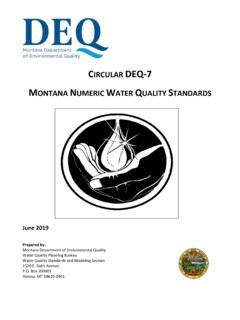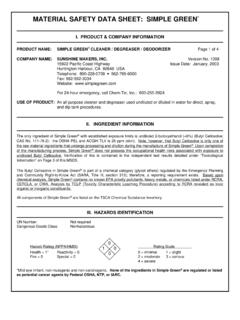Transcription of Total Suspended Solids (TSS) are solids in water that can be …
1 Total Suspended Solids (TSS) are Solids in water that can be trapped by a filter. TSS can include a wide variety of material, such as silt, decaying plant and animal matter, industrial wastes, and sewage. High concentrations of Suspended Solids can cause many problems for stream health and aquatic life. Total Dissolved Solids (TDS) are Solids in water that can pass through a filter (usually with a pore size of micrometers). TDS is a measure of the amount of material dissolved in water . This material can include carbonate, bicarbonate, chloride, sulfate, phosphate, nitrate, calcium, magnesium, sodium, organic ions, and other ions.
2 A certain level of these ions in water is necessary for aquatic life. Similar to TSS, high concentrations of TDS may also reduce water clarity, contribute to a decrease in photosynthesis, combine with toxic compounds and heavy metals, and lead to an increase in water temperature. TDS is used to estimate the quality of drinking water , because it represents the amount of ions in the water . water with high TDS often has a bad taste and/or high water hardness, and could result in a laxative effect. The Environmental Protection Agency sets a secondary standard of 500 mg/L TDS in drinking water .
3 Secondary standards are unenforceable, but recommended, guidelines for contaminants that may cause cosmetic or aesthetic effects in drinking water . High TDS concentrations can produce laxative effects and can give an unpleasant mineral taste to water . Hardness is measure of polyvalent cations (ions with a charge greater than +1) in water . Hardness generally represents the concentration of calcium (Ca2+) and magnesium (Mg2+) ions, because these are the most common polyvalent cations. Other ions, such as iron (Fe2+) and manganese (Mn2+), may also contribute to the hardness of water , but are generally present in much lower concentrations, particularly in surface waters.
4 Waters with high hardness values are referred to as "hard," while those with low hardness values are "soft". Hardness affects the amount of soap that is needed to produce foam or lather. Hard water requires more soap, because the calcium and magnesium ions form complexes with soap, preventing the soap from sudsing. Hard water can also leave a film on hair, fabrics, and glassware. Hardness of the water is very important in industrial uses, because it forms scale in heat exchange equipment, boilers, and pipes. Some hardness is needed in plumbing systems to prevent corrosion of pipes. Hardness mitigates metals toxicity, because Ca2+ and Mg2+ help keep fish from absorbing metals such as lead, arsenic, and cadmium into their bloodstream through their gills.
5 The greater the hardness, the harder it is for toxic metals to be absorbed through the gills. Because hardness varies greatly due to differences in geology, there are no general standards for hardness. The hardness of water can naturally range from zero to hundreds of milligrams per liter (or parts per million). Waters with a Total hardness in the range of 0 to 60 mg/L are termed soft; from 60 to 120 mg/L moderately hard; from 120 to 180 mg/L hard; and above 180 mg/L very hard. nitrogen is required by all organisms for the basic processes of life to make proteins, to grow, and to reproduce. nitrogen is very common and found in many forms in the environment.
6 inorganic forms include nitrate (NO3), nitrite (NO2), ammonia (NH3), and nitrogen gas (N2). Organic nitrogen is found in the cells of all living things and is a component of proteins, peptides, and amino acids. Nitrate (NO3) is highly soluble (dissolves easily) in water and is stable over a wide range of environmental conditions. It is easily transported in streams and groundwater. Nitrates feed plankton, aquatic plants, and algae, which are then eaten by fish. Nitrite (NO2) is relatively short-lived in water because it is quickly converted to nitrate by bacteria. Excessive concentrations of nitrate and/or nitrite can be harmful to humans and wildlife.
7 Phosphorus (P) is a nutrient required by all organisms for the basic processes of life. Phosphorus is a natural element found in rocks, soils and organic material. Phosphorus clings tightly to soil particles and is used by plants, so its concentration in clean waters is generally very low. However, phosphorus is used extensively in fertilizer and other chemicals, so it can be found in higher concentrations in areas of human activity. Many seemingly harmless activities added together can cause phosphorus overloads. Phosphorus exists in water in either a particulate phase or a dissolved phase. Particulate matter includes living and dead plankton, precipitates of phosphorus, phosphorus adsorbed to particulates, and amorphous phosphorus.
8 The dissolved phase includes inorganic phosphorus and organic phosphorus. Phosphorus in natural waters is usually found in the form of phosphates (PO4-3). Phosphates can be in inorganic form (including orthophosphates and polyphosphates), or organic form (organically-bound phosphates). Organic phosphate is phosphate that is bound to plant or animal tissue. Organic phosphates are formed primarily by biological processes. They are contributed to sewage by body waste and food residues, and also may be formed from orthophosphates in biological treatment processes or by receiving water biota. Organic phosphates may occur as a result of the breakdown of organic pesticides which contain phosphates.
9 They may exist in solution, as loose fragments, or in the bodies of aquatic organisms. inorganic phosphate is phosphate that is not associated with organic material. Types of inorganic phosphate include orthophosphate and polyphosphates. Orthophosphate is sometimes referred to as "soluble reactive phosphorus (SRP)." Orthophosphate is the most stable kind of phosphate, and is the form used by plants. Orthophosphate is produced by natural processes and is found in sewage. Polyphosphates (also known as metaphosphates or condensed phosphates) are strong complexing agents for some metal ions. Phosphates are not toxic to people or animals unless they are present in very high levels.
10 Digestive problems could occur from extremely high levels of phosphate. In freshwater lakes and rivers, phosphorus is often found to be the growth-limiting nutrient, because it occurs in the least amount relative to the needs of plants. If excessive amounts of phosphorus and nitrogen are added to the water , algae and aquatic plants can be produced in large quantities. When these algae die, bacteria decompose them, and use up oxygen. This process is called eutrophication. Alkalinity is a measure of the buffering capacity of water , or the capacity of bases to neutralize acids. Measuring alkalinity is important in determining a stream's ability to neutralize acidic pollution from rainfall or wastewater.




